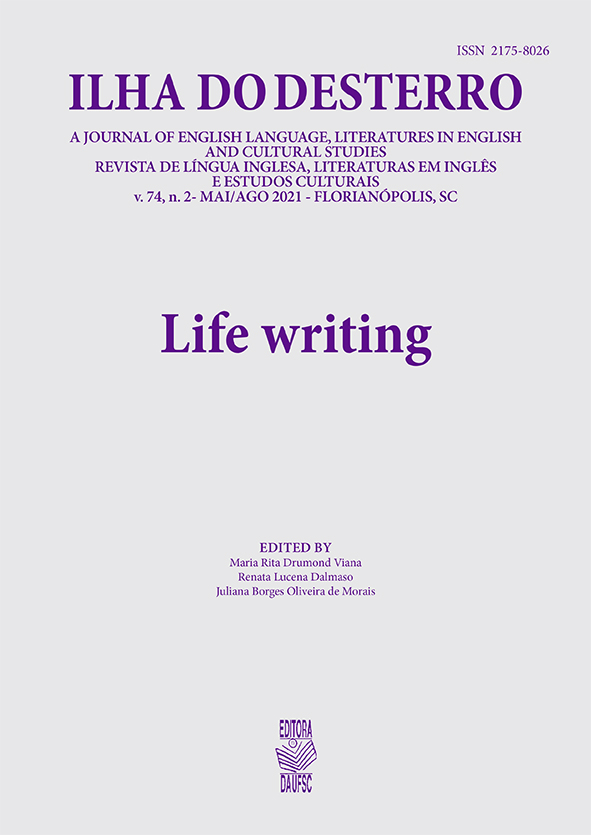Confundindo Lethe no Moyola: Heaney, Virgil e o Inconsciente Cultural
DOI:
https://doi.org/10.5007/2175-8026.2021.e78994Resumo
Este ensaio discute "Route 110", de Seamus Heaney, publicado em Human Chain, como um exemplo de escrita da si incorporada no gênero específico da poesia. Seu uso do Livro VI da Eneida de Virgílio como um tipo de inconsciente cultural é examinado, e cada uma das obras é vista como tesserae, que são reunidas como uma espécie de mosaico por meio da tradução e de uma perspectiva dupla. Heaney descreveu essa sequência poética como uma tentativa de traduzir partes do Livro VI da Eneida. ‘Route 110’ também é lida à luz da tradução de Heaney do Livro VI da Eneida, e todos os três textos unem-se e se combinam para formar o mosaico de aspectos significativos de sua vida, visto da perspectiva da senioridade. A sequência é lida em termos da conexão entre os dois livros como uma tentativa de explorar aspectos de Eros e Thanatos em sua própria escrita.
Referências
Bloom, Harold. The Anxiety of Influence: A Theory of Poetry. Oxford: Oxford University Press, 1973.
Borch-Jacobsen, Mikkel. The Emotional Tie: Psychoanalysis, Mimesis, and Affect. Translated by Douglas Brick and others. Stanford University Press, 1992.
Brooks, Peter and Alex Woloch. Whose Freud?: The Place of Psychoanalysis in Contemporary Culture. Yale University Press, 2000.
Dawe, Gerald. The Poetry Programme. RTE Radio 1, October 4, 2008.
Easthope, Anthony. The Unconscious. Routledge, 1999.
Eliot, T. S. Collected Poems, 1909-1962. Harcourt, Brace & World, Inc, 1963.
Evans, James Allan, editor. Arts & Humanities through the Eras Ancient Greece and Rome 1200 B.C.E.–476 C.E., vol. 2. Thomson Gale, 2005.
Freud, Sigmund. New Introductory Lectures on Psychoanalysis, vol. 22, Hogarth Press, 1933.
Gadamer, Hans-Georg. The Relevance of the Beautiful and Other Essays. Edited by Robert Bernasconi. Translated by Nicholas Walker. Cambridge University Press, 1986.
Heaney, Seamus. Field Work. Faber, 1979.
Heaney, Seamus. Station Island. Faber 1984.
Heaney, Seamus. The Haw Lantern. Faber 1987.
Heaney, Seamus. The Spirit Level. Faber, 1996.
Heaney, Seamus. Human Chain. Faber, 2010.
Heaney, Seamus. Aeneid Book VI. Faber, 2016.
Heaney, Seamus and Dennis O’Driscoll. Stepping Stones: Interviews with Seamus Heaney. Faber, 2008.
Heininger, Joseph. ‘Making a Dantean Poetic: Seamus Heaney’s “Ugolino”.’ New Hibernia Review, vol. 9, no. 2 (Summer), 2005, pp. 50-64.
Lacan, Jacques. Écrits: The First Complete Edition in English. Translated by Bruce Fink in collaboration with Héloïse Fink and Russell Grigg. W. W. Norton, 2006.
Lacan, Jacques. The Four Fundamental Concepts of Psycho-Analysis. Translated by Alan Sheridan. Hogarth Press, 1977.
Lacan, Jacques. Seminar 7 The Ethics of Psychoanalysis, 1959-1960. Translated by Jacques-Alain Miller, Tavistock/Routledge, 1992.
Matthews, Steven. Irish Poetry: Politics, History, Negotiationthe Evolving Debate, 1969 to the Present. Macmillan, 1997.
Molino, Michael R. ‘The Freed Speech of “Equivocal Words”: Seamus Heaney’s Door into the Light.” “The Soul Exceeds Its Circumstances”: The Later Poetry of Seamus Heaney, edited by Eugene O’Brien. Notre Dame University Press, 2016, pp. 898-106.
O’Donoghue, Bernard. Seamus Heaney and the Language of Poetry. Harvester Wheatsheaf, 1994.
Ormsby, Frank, editor. The Collected Poems of John Hewitt. Blackstaff Press, 1991.
Parker, Michael. ‘“Back in the Heartland”: Seamus Heaney’s “Route 110” Sequence in Human Chain.’ Irish Studies Review, vol. 21, no. 4, 2013, pp. 374-386.
Parker, Michael. ‘“His Nibs”: Self-Reflexivity and the Significance of Translation in Seamus Heaney’s Human Chain.’ Irish University Review, vol. 42, no. 2, 2012, pp. 327-350.
Putnam, Michael C. J. ‘Virgil and Heaney: “Route 110”.’ Arion: A Journal of Humanities and the Classics, vol. 19, no. 3 (Winter 2012), 2012, pp. 79-108.
Singer, Alan. Aesthetic Reason: Artworks and the Deliberative Ethos. Pennsylvania State University Press, 2003.
Thwaites, Tony. Reading Freud: Psychoanalysis as Cultural Theory. SAGE Publications, 2007.
Tobin, Daniel. Passage to the Center: Imagination and the Sacred in the Poetry of Seamus Heaney. University Press of Kentucky, 1999.
Tochigi, Nobuaki. ‘Poetry Redressed, or the Resilience of Language in Seamus Heaney’s “Squarings”.’ The Harp, vol. 9, 1994, pp. 73-82.
Virgil. The Aeneid. Translated by Robert Fagels. Viking, 2006.
Downloads
Publicado
Edição
Seção
Licença
Copyright (c) 2021 Eugene OBrien

Este trabalho está licenciado sob uma licença Creative Commons Attribution 4.0 International License.
A revista Ilha do Desterro publica artigos e resenhas inéditos, referentes as áreas de Inglês, Literaturas em Língua Inglesa e Estudos Culturais. Publica volumes mistos e/ou temáticos, com artigos e resenhas em inglês e português.
Autores mantém os direitos autorais e concedem à revista o direito de primeira publicação, com o trabalho simultaneamente licenciado sob a Licença Creative Commons Attribution que permite o compartilhamento do trabalho com reconhecimento da autoria e publicação inicial nesta revista.

This work is licensed under a Creative Commons Attribution 4.0 International License.



